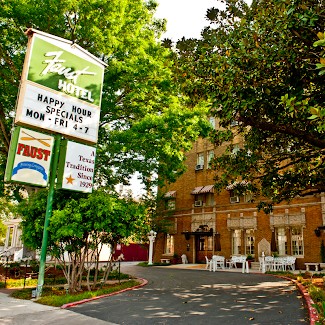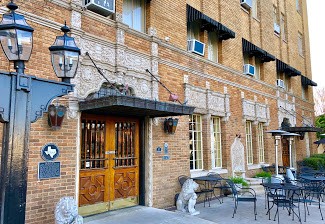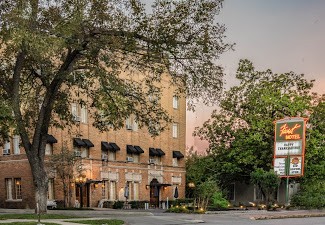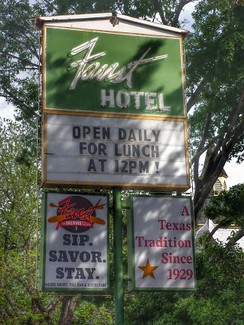Faust Hotel and Brewpub
Introduction
Text-to-speech Audio
Images




Backstory and Context
Text-to-speech Audio
During the middle years of the 1920s, central Texas experienced a debilitating drought which adversely affected New Braunfels’ largely agricultural economy. A group of citizens working through the relatively new Chamber of Commerce suggested that a modern hotel could attract tourist and convention traffic, and thereby lessen the impact of unpredictable weathers patterns on the local economy. It was argued that such a hotel could also provide lodging and display space to drummers from midwestern to northeastern states, who for years made New Braunfels a regular stop on their sales travels through the state. The idea looked promising and a committee composed of nine members of the Chamber of Commerce was formed to study the proposal. From that committee, the New Braunfels Hotel Company was formed. The Company’s task was to fund and build a new modern hotel for New Braunfels.
Other factors, contemporary in impact, influenced the committee’s desire to build a fancy, prestigious hotel. Tourist, convention, and railroad traffic in Central Texas had long been recognized as economically viable. In response, several communities, mostly large but some small, had built hotels. The Park/Plaza and Aumont in Seguin, the only hotels in the state known to be comparable to the Faust in architectural presence, era, service, and location, had been constructed in 1917. In 1927, the Von Minden of nearby Schulenburg was built, and was considerably more modest than the Faust. Added to these contemporary precedents was the incentive that a modern, medium-rise hotel in a town the size of New Braunfels would be a forceful statement in Central Texas of civic pride, prestige, and progress. Thus, although a variety of economic arguments proved the compelling reasons to build a hotel, factors such as social tradition, precedent, and civic pride played their part too.
The Hotel Company’s task of securing funds for the $150,000 project was significantly facilitated by the actions of a prominent New Braunfels’ family. The Jospeh Faust estate, whose executor was Walter Faust, the late Senator’s son, donated the large Joseph Faust house and land as the future hotel site. Through that pledge, appraised at $36,000, and Faust’s individual subscription for $5,000, the Faust family held $41,000 in hotel stock.
With these individual subscriptions pledged and a desirable site secured on a major artery of New Braunfels, the Hotel Company elected its Board of Directors and officers. All prominent citizens of New Braunfels, the Board consisted of Emil Fischer, Walter Faust, B. W. Nuhn, H. R. Fuchs, Adolph Henne, U. S. Pfeuffer, R. J. Gode, Emil Heinen, and I. A. Ogden. Faust, Pfeuffer, and Ogden were subsequently elected chairs of the Executive, Finance, and Building Committees, respectively.
A secret ballot among the Directors resulted in Harvey Partridge Smith as the choice for project architect. Smith was a young promising San Antonio architect who was becoming widely known in Central and South Texas. Born in Minneapolis (1889) and educated at the Chicago Institute of Art, Northwestern University and the University of Arizona, Smith arrived in San Antonio in 1907. In approximately 1918, he and R. B. Kelly formed a partnership that lasted until about 1925. Smith then established his own firm which he headed until his death in 1964.
The opening celebration on October 12, 1929 of the new $162,000 hotel was a gala event. Approximately two thousand persons from the New Braunfels’ area were reported to have attended. New Braunfels’ mayor, H. A. Triesch presided at the formal opening banquet where three hundred guests were served an eight-course meal. Speeches were given by luminaries from New Braunfels and San Antonio. Although Governor Dan Moody did not arrive as anticipated, festivities nonetheless continued through the night, with many guests staying until morning.
Observers’ of the Faust’s first three decades say that although it never fulfilled its founders’ high aspirations for profitability, the Faust did well particularly during the 1930s. During the decades that earned it a reputation, serving New Braunfels’ service organizations, social circles, business functions, convention, and tourist traffic. In 1936, the hotel was renamed the Hotel Faust to commemorate the Faust family and Walter Faust who had died three years earlier.
Sources
Hotel Faust, National Register of Historic Places. Accessed January 9th 2021. https://catalog.archives.gov/id/40971551.
History of the Faust Hotel, Faust Hotel & Brewing Co. . Accessed January 9th 2021. https://fausthotel.com/.
